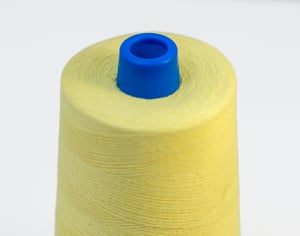
If you’ve come across the term Cotton Count and were a bit confused, you’re not alone. The terminology of the yarn and thread industry can be tricky.
3 Common Thread Terms
Cotton Count, Tex, and Denier are three common terms you’ll frequently see in the specs for thread and yarn. Here’s how they’re different.
In this post, we’ll explain the meaning of Cotton Count and distinguish it from similar terms. Let’s start by providing some definitions of commonly-confused thread sizing words, so the differences among them become clear.
- Cotton Count (NeC): The number of 840 yard lengths of material in one pound.
- Tex: The weight in grams of 1,000 meters of thread.
- Denier: The weight in grams of 9,000 meters of thread.
As you can see, Cotton Count is the length by weight, and Tex and Denier are the weight by length. All three are essentially just different ways of expressing how much thread you have.
Cotton Count for Spun Fibers
Cotton Count is specifically a way of describing the size of spun fibers and yarns. Now let’s take a closer look at what that means.
Cotton Count looks at one pound of the material and describes how many 840-yard lengths of spun fiber it contains. Here’s a breakdown of when and why you would use Cotton Count, as opposed to other terms, to describe thread material:
- Tex is a very common and general way of describing the weight of a yarn or thread, however it does not distinguish the actual construction of a material.
- If you have a multi-filament yarn or thread, Denier and Decitex (Tex/10) are the most commonly used terms.
- For a spun yarn or thread, Cotton Count is the appropriate term.
The Meaning of Spun
Spun yarns are manufactured by interlocking staple fibers, which creates a stronger and more durable result. This yarn is traditionally measured in Cotton Count, or NeC, even if it’s not actually made of cotton.
The NeC of a polyester, aramid or other spun yarn is the number of 840 yard (one hank) lengths required to make one pound of that material. There are three primary types of spun yarn:
- Ring Spun. This is the type with the smallest diameter, the most strength, and the most linting.
- Air Jet Spun. This type has the lowest strength and the least linting.
- Open End Spun. This is a medium-strength type with the largest diameter.
Linting is the propensity of a yarn to shed or pill during use. Any company that works with spun fibers will be familiar with linting, which is undesirable but to some extent unavoidable.
Cotton Count: An Example
To understand how Cotton Count works when you’re comparing yarn and thread options, let’s look at the example of spun polyester.
A 12/4 spun polyester has an overall Cotton Count of 3, which is 12 divided by 4. It’s 12 divided by 4 because the single end of yarn used to make thread was a Cotton Count of 12, and 4 ends were combined to make a thread - meaning an overall Cotton Count of 3.
To calculate the estimated yield of this yarn, multiply the overall Cotton Count by 840 yards. That’s 3 multiplied by 840 yards, yielding 2,520 yards per pound, or:
3 x 840 yds = 2,520 yds/lb
How to Use Cotton Count in Selecting Yarn
If you are considering using spun yarn and examining related Cotton Counts, here are a few things to keep in mind:
- Unlike direct measurement systems, smaller Cotton Counts equal larger yarns.
- Because all yarn measuring systems are based on the weight and length of material, you can convert a Cotton Count to its equivalent Denier size by using the following formula: 5315/Count (NeC) = Denier
- If overall size is the most important aspect of your application, then you can use various combinations of plied materials to achieve the same Cotton Count. For example, a 12/6 thread is the same effective Cotton Count as an 8/4 thread.
- As you come across terms like NeC, Tex, and Denier, keep in mind that you can always use our yarn size conversion calculator for quick reference.
Making the Right Choice
Cotton Count can be confusing, but we hope this post has helped you understand what it means and how to use it in yarn and thread selection. Making the right choice is of critical importance in saving time and money.
Connect with Service Thread for more information about Cotton Count or size is right for your industrial application.



